The design and operation of the bag filter: the pros and cons + features of replacing the filter bag
Of course, compliance with environmental standards is an important condition for the successful and safe functioning of any production. The purification of air contaminated with processed products is the main requirement for mining, cement, chemical, flour, metallurgical and other enterprises, in the process of which a large amount of dust, soot and other microscopic pollutants is generated.
But modern cleaning structures can effectively solve the problem of excessive dustiness of the air: the device and the operation of the bag filter are aimed specifically at removing the smallest particles of harmful suspensions. After installing this unit, all dust and dirt settle on the walls of the filter, and lighter and free of impurities air is emitted into the atmosphere.
In this material, we will consider the structure and principles of the bag filter, learn about how to self-regenerate and replace them, and also reveal the advantages and disadvantages of this cleaning design.
The content of the article:
The need for air purification in production
The environmental crisis on the planet is aggravated every day. Manufacturing enterprises play an important role in this: chemical leakage, pollution of water bodies by sewage and dust emissions adversely affect both the state of nature and human health.
In addition to direct harm to workers and residents living near production, dust causes damage to the enterprise itself. Dust deposits adversely affect the operation of the equipment, worsens the conditionventilation system and heat exchangers.These factors can lead to a decrease in the quality of manufactured products and even increase their cost due to breakdowns and faster wear of the equipment used.
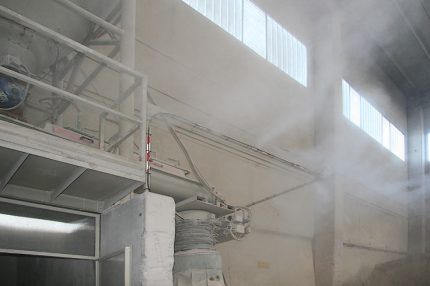
That is why high-quality dust collection and neutralization is an integral stage of the entire technological process in production. The bag filter effectively copes with the tasks and protects not only nature and people, but also the equipment of the enterprise.
How is the bag filter arranged and working?
Cleaning equipment with a bag filter can be used as part of internal ventilation, providing for the return of purified air back to the room, as well as a system of complete air purification before it is discharged into the environment.
Bag filter is a fairly simple design, which consists of the main elements:
- housings for filter units;
- chambers for clean and dirty air;
- hoppers and supports;
- an inlet valve through which the air mixture passes;
- a cleaning sleeve or a complex of sleeves that are located in the air path;
- an outlet valve with a pressure regulator passing through the cleaned stream;
- filter regeneration system, which allows you to periodically clean the sleeve from dust.
The design of the device is designed to pass a sufficiently large amount of air or gas. Flows carried away by the inlet valve pass through the system, leaving particles of dust or soot on the surface of the filter on a woven or non-woven basis.
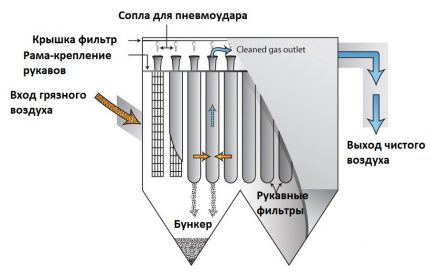
The filter can be single, but complexes with a battery of sleeves, which more effectively clean the air, remain more effective. After the sleeve, the recycled air is discharged through an outlet valve equipped with automatic equipment for regulating the pressure.
In fact, the design performs three main tasks:
- qualitatively cleans the gas-air mixture from pollutants;
- provides uniformity of dust loading;
- adjusts the amount of air coming in for filtering.
The separation of small particles in the exhaust air makes it possible to ensure the proper purity of the exhaust stream. Unwanted suspensions are firmly held inside the sleeve, which is self-cleaning during the regeneration phase.
The main types of filter bags
The selection of a suitable bag filter is based on the characteristics of the production and the nature of the dust produced during its process. The main criteria that should be relied upon in the selection of this equipment are the performance of the installation and the depth of purification of the incoming air. The remaining parameters are individual: the degree of their importance depends on the production conditions.
For example, the choice of material from which the filter is made depends entirely on the characteristics of dust pollutants that occur during production.
No. 1: Difference in equipment performance
Bag filters are divided into two main types: round and flat. The first type is designed for operation in enterprises with a large dust load and is capable of passing and cleaning quite serious volumes of air: more than 100 thousand m3 in hour.
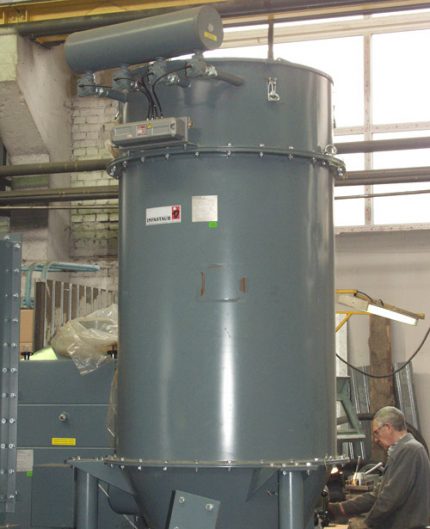
Flat sleeves have more modest performance, but they also have a more compact design.Such cleaning systems are suitable for workshops with a small dust load.
No. 2: Classification by the type of installation of hoses
By the type of installation, systems with bag filters can be vertical or horizontal. The latter remain more effective as they let in more air or gas.
The flow path along the sleeve itself is quite long, so the pores of the filter material trap more pollutants.
Sleeves are also distinguished in shape: ellipsoidal, cylindrical, rectangular.
No. 3: Varieties by material of manufacture
The classification and principle of operation of the bag filter is also affected by the material from which the filter element is made. Often it is made of fabric.
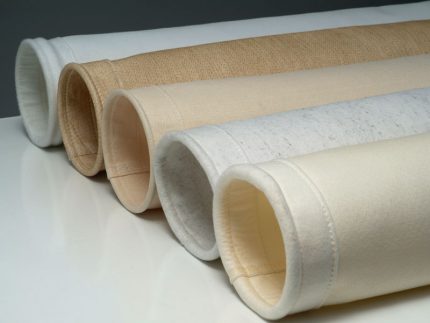
It can be either natural cotton or wool, or synthetic materials:
- polyester;
- fiberglass;
- polyamide;
- meta-aramid;
- polytetrafluoroethylene;
- polyacrylonitrile, etc.
The choice of sleeve material is based on the type of production, the characteristics of the mixture being filtered, the dispersion and the properties of dust, and the aggressiveness of the medium.
Recently, nonwoven filters with a more uniform and finely porous structure, which retain more pollutants due to the fibrous surface, have been especially popular.
No. 4: Classification by the method of regeneration
The filter recovery method can be considered another classification category for these devices. The regeneration of the hose assembly is an important stage in the construction, so it is worth paying special attention to it.
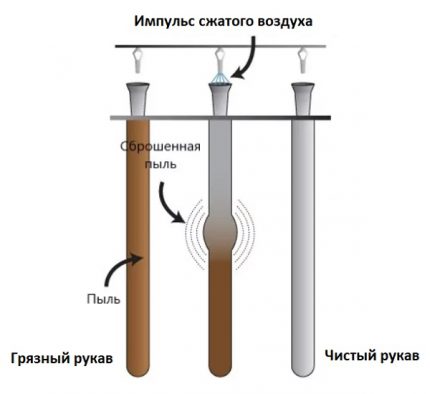
In fact, regeneration is a process of cleaning the sleeve of accumulated dirt.
The procedure can be carried out by several methods, the choice of which depends on the nature of the dust:
- Vibrocleaningduring which the sleeve or battery of the sleeves is shaken intensively, after which the particles of impurities fall into a special hopper for subsequent removal. Dust is removed from it by means of a dust transport system: a screw or pneumatic conveyor, a rotary vestibule, a scraper chain, a slide gate or a valve.
- Pulse purge or air purification. The filter is subjected to pulsed purging or pneumatic cleaning using a reverse air flow, which knocks out microparticles from the pores.
- Combined cleaning. The battery or single sleeve is subjected to combined cleaning, during which the filter is shaken and surrounded by streams of clean air.
Vibro-cleaning can occur not only automatically: the regeneration process is sometimes carried out manually thanks to a special handle and is called mechanical cleaning of the sleeve.
But most often, the regeneration process is carried out automatically due to the work of pollution sensors, which respond to the amount of litter collected and determine the pressure and throughput of the sleeve. If the pressure at the outlet of the structure drops, the sensor starts the purge process or the shaking mechanism.

With a low dust load in a non-aggressive environment in a small production area, the full functioning of the bag filter can reach five years, after which it will need to be replaced regularly.
Bag Filter Replacement Features
Like the installation, the replacement of used filters is carried out on the basis of design documentation and the conditions in which the cleaning device operates.
Many key factors are taken into account:
- dust load;
- dispersion of dust and its quality;
- characteristics of the working environment;
- filter performance;
- place of installation;
- mixture cleaning depth, etc.
If only one sleeve is out of order in the battery, you can cut off its operation without replacement. To do this, the filter is clogged at the level of the tube sheet. There is no need to remove the purge pipe or frame.
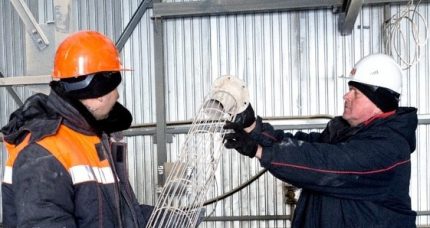
If the node requires a complete replacement, you must perform the following steps:
- Close the shutters at the entrance and exit to the compartment, if this is provided for by the design features of the system.
- Through the inspection window, remove the purge pipe leading to the replaceable sleeve or battery.
- Remove the sleeve frame.
- Remove the sleeve from the structure. It can be lifted along the tube sheet or dumped into the dust bin. In the latter case, the filter will need to be removed from the compartment through the inspection window.
- Install the new sleeve in the reverse order. After connecting, fasten the frame, lead the purge pipe.
After replacement measures, it is necessary to carry out a test run of the equipment to make sure that it is working.
It is better to entrust a replacement to a specialized company whose employees have the skills and experience in removing and installing bag filters.
We also have an article on the site with detailed instructions on replacing the filter in the supply ventilation.
Advantages and disadvantages of devices
Like any other cleaning equipment and systems, for example, aspirationThe bag filter has its own operating features, during which the characteristic advantages and disadvantages of the system are identified.
The advantages of this complex are much greater than flaws, so bag filters are widely used in various fields of production.
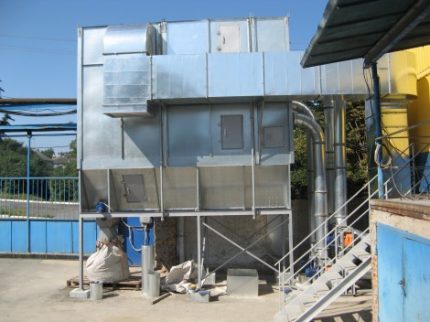
The indisputable advantages of bag filters include the following features:
- The design is universal, therefore it is easily integrated into the ventilation and purification systems of various industrial sectors.
- The complex with a bag filter is easily integrated into the production line and is not very demanding on the amount of space required for its arrangement.
- The degree of purification of the gas-air mixture reaches 90-99%, which is an extremely high indicator for the dry cleaning system.
- Filtration is equally effective both at extremely low air temperature, and in a heated room.
- Management of the complex is very simple and can be fully automated.
- Scheduled replacement of used bag filters is carried out once every two to three years.
In addition to the advantages, the bag filter has minor disadvantages. The main one is the need for compressed air supply in conditions of filtration of air volumes of more than 150 m3 in hour.
For certain types of production or aggressive operating conditions, filters from expensive materials, such as fiberglass or meta-aramid, which are more resistant to wear, may be needed.
Other types of filters are also used in the ventilation system. Read more about air and coal filtration systems. in the next article.
Conclusions and useful video on the topic
The structure and principle of operation of the cleaning system with a bag filter is clearly shown in the video below:
The process of testing the sleeves and the filter cleaning mechanism was demonstrated by the manufacturer of cleaning equipment:
Bag filter is one of the simplest and most effective ways to dry clean air from dust of various origin. A universal system can be successfully integrated into almost any technological process, during which large volumes of filtration medium are formed, requiring the maximum removal of unwanted suspensions. Sleeves are quite simple to replace, do not require complicated or expensive maintenance. Therefore, the owners of production facilities should definitely look at this type of purification of exhaust air.
Do you want to supplement the above material with useful information or talk about the features of the use of filters based on personal experience? Write your comments and additions, ask questions to our experts - the feedback block is located below.

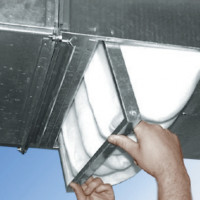 Replacing the filter in the supply ventilation: selection features + filter replacement instructions
Replacing the filter in the supply ventilation: selection features + filter replacement instructions 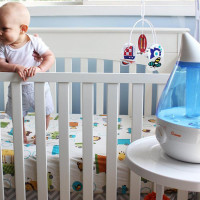 Pros and Cons of a Humidifier for a Baby: A Real Assessment of Use
Pros and Cons of a Humidifier for a Baby: A Real Assessment of Use 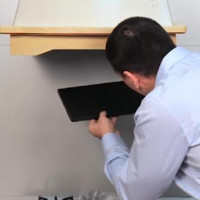 Charcoal filter for hood: device, principle of operation and replacement technology
Charcoal filter for hood: device, principle of operation and replacement technology 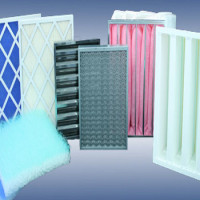 Filters for ventilation: types, features and disadvantages of each type + how to choose the best
Filters for ventilation: types, features and disadvantages of each type + how to choose the best 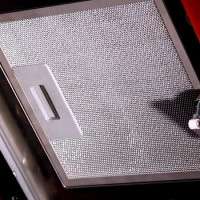 Fat filters for hoods: varieties, their features and disadvantages + how to choose
Fat filters for hoods: varieties, their features and disadvantages + how to choose 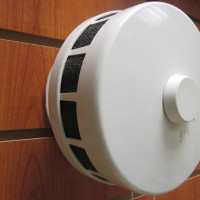 Which supply valve to choose: varieties of valves, features of choice + overview of the best brands
Which supply valve to choose: varieties of valves, features of choice + overview of the best brands  How much does it cost to connect gas to a private house: the price of organizing gas supply
How much does it cost to connect gas to a private house: the price of organizing gas supply  The best washing machines with dryer: model rating and customer tips
The best washing machines with dryer: model rating and customer tips  What is the color temperature of light and the nuances of choosing the temperature of the lamps to suit your needs
What is the color temperature of light and the nuances of choosing the temperature of the lamps to suit your needs  Replacement of a geyser in an apartment: replacement paperwork + basic norms and requirements
Replacement of a geyser in an apartment: replacement paperwork + basic norms and requirements